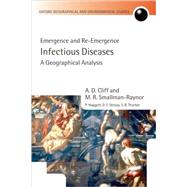Infectious Diseases: A Geographical Analysis Emergence and Re-emergence
, by Cliff, A. D.; Smallman-Raynor, M.R.; Haggett, P.; Stroup, D.F.; Thacker, S.B.- ISBN: 9780199244737 | 0199244731
- Cover: Hardcover
- Copyright: 9/28/2009
The last four decades of human history have seen the emergence of an unprecedented number of 'new' infectious diseases: the familiar roll call includes AIDS, Ebola, H5N1 influenza, hantavirus, hepatitis E, Lassa fever, legionnaires' and Lyme diseases, Marburg fever, Rift Valley fever, SARS,and West Nile. The outbreaks range in scale from global pandemics that have brought death and misery to millions, through to self-limiting outbreaks of mainly local impact. Some outbreaks have erupted explosively but have already faded away; some grumble along or continue to devastate as nowpersistent features in the medical lexicon; in others, a huge potential threat hangs uncertainly and worryingly in the air. Some outbreaks are merely local, others are worldwide.This book looks at the epidemiological and geographical conditions which underpin disease emergence. What are the processes which lead to emergence? Why now in human history? Where do such diseases emerge and how do they spread or fail to spread around the globe? What is the armoury of surveillanceand control measures that may curb the impact of such diseases? But, uniquely, it sets these questions on the modern period of disease emergence in an historical context. First, it uses the historical record to set recent events against a much broader temporal canvas, finding emergence to be aconstant theme in disease history rather than one confined to recent decades. It concludes that it is the quantitative pace of emergence, rather than its intrinsic nature, that separates the present period from earlier centuries. Second, it looks at the spatial and ecological setting of emergence,using hundreds of specially-drawn maps to chart the source areas of new diseases and the pathways of their spread. The book is divided into three main sections: Part 1 looks at early disease emergence, Part 2 at the processes of disease emergence, and Part 3 at the future for emergentdiseases.







